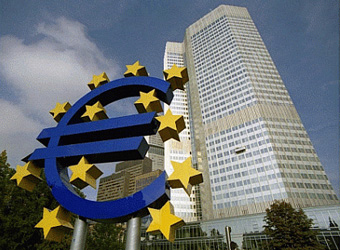The European Central Bank left interest rates on hold and unveiled no other measures to bolster a fragile euro zonerecovery on Thursday despite forecasting low inflation for years to come.
The ECB left its main interest rate at 0.25 percent, a move generally expected by markets, and held the deposit rate it pays banks for holding their money overnight at zero.
New forecasts from ECB staff put inflation at 1.0 percent this year, 1.3 percent in 2015 and 1.5 percent in 2016 – below its target of close to 2 percent all the way through the projection.
ECB President Mario Draghi told a news conference that the latest economic information suggested recovery was on track and needed no extra push for now.
“We saw our (economic) baseline by and large confirmed,” he said. “The news that has come out since the last monetary policy meeting is also, I would say, by and large on the positive side.”
Inflation has been in what Draghi calls the “danger zone” below 1 percent for five months now and was running at 0.8 percent at the last count.
The new forecasts saw the euro zone economy growing by 1.8 percent in 2016 after 1.5 percent in 2015 and 1.2 percent this year, a slight upwards revision from its previous 2014 estimate but well below what is considered a trend rate of growth.
“Annual HICP (EU harmonized) inflation rates are expected to remain at around current levels in the coming months,” Draghi said. “Thereafter, inflation rates should gradually increase and reach levels closer to 2 percent.”
The forecasts presume an unchanged exchange rate and falling oil prices.
Draghi rejected comparisons with Japan’s experience of deflation which became so entrenched that companies and households held off on spending on expectations of lower prices ahead, leading to two decades of economic stagnation.
ECB policymakers have insisted that so far there is no sign of euro zone citizens deferring spending plans.
The lack of action was significant since last month Draghi had signaled that by the March policy meeting the ECB would have enough information to judge the need for fresh stimulus.
The International Monetary Fund believes more needs to be done.
Reza Moghadam, head of the IMF’s European Department, said in a blog on Wednesday that the ECB should cut interest rates and pump out more money, perhaps through QE.
NO MOVE ON LIQUIDITY
Like the Bank of Japan, which meets to set policy next week, the ECB is running out of room to cut interest rates putting the onus on alternative policy measures.
An ECB source had predicted it would stop offsetting money it put into the financial system through government bonds it bought at the height of the euro debt crisis by withdrawing an equivalent amount of funds from week to week.
ECB policymaker Ewald Nowotny told Reuters last month that he and his colleagues were nearing unanimity on what would have marked a big philosophical shift and a step towards U.S.-style quantitative easing (QE).
The resultant release of around 175 billion euros ($240 billion) would have roughly doubled the amount of excess liquidity in the financial system, helping to bring down interbank lending rates.
But Draghi said there was no sign of back door monetary tightening via climbing money market rates and therefore no need to act, for now at least.
“The suspension of sterilization … is one of the instruments that is in our list but we didn’t see any development in the money markets that would lead to that unwanted tightening of monetary conditions that would justify the use of this instrument,” he said.
He added that the benefits of such a move would be limited since most of the government bonds the ECB holds would mature in a few years.
Source: Reuters



